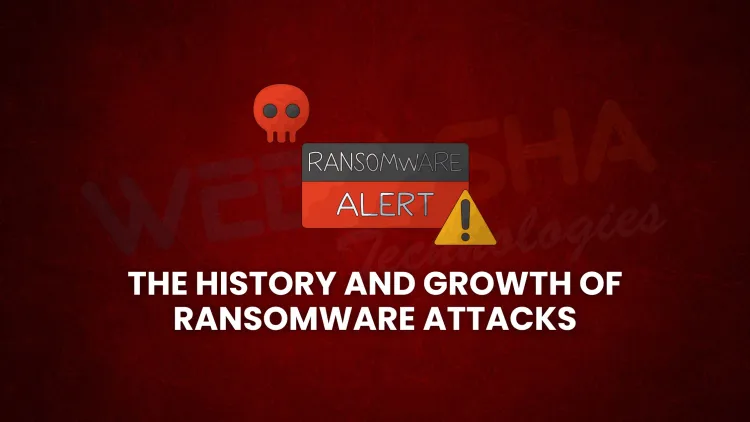What is the origin of ransomware and how has it evolved over time?
Ransomware began in 1989 with the AIDS Trojan, a virus that locked files and demanded money via postal mail. Since then, it has evolved into a powerful cyberweapon using advanced encryption, cryptocurrencies, and global-scale delivery methods. From early fake antivirus scams to modern attacks like WannaCry and NotPetya, ransomware has grown into a billion-dollar cybercrime industry. This blog explores the first ransomware attack, how the threat has developed over the years, major incidents that shaped cybersecurity history, and how users and businesses can protect themselves today.

Once upon a file...
Imagine waking up, turning on your computer, and seeing a strange message:
"Your files have been locked. Pay $300 in Bitcoin to get them back."
Scary, right? This is called ransomware, and it’s one of the most dangerous threats in the digital world today. But how did it all begin? Let’s go back in time and explore the story of ransomware—from its humble (and harmful) beginnings to how it became a global cyber nightmare.
How did ransomware begin?
The story of ransomware started all the way back in 1989 with a sneaky program called the AIDS Trojan, also known as the PC Cyborg Virus.
The first ransomware attack:
A man named Dr. Joseph Popp, a biologist, mailed 92,000 infected floppy disks to people, mostly those attending an AIDS conference. These disks contained a program that looked like it was giving information about AIDS, but after 90 boots, it would lock the files and demand $189 to be sent to a P.O. box in Panama.
At that time, very few people had even heard of the term “ransomware.” But this marked the birth of a new type of digital crime.
The evolution: From floppy disks to global attacks
2000s – The Rise of Fake Antivirus Ransomware
Cybercriminals started tricking users by showing fake antivirus warnings. They would say your computer was infected and that you needed to pay to "clean" it. This wasn’t as advanced as today’s attacks, but it worked on many people.
2013 – CryptoLocker changes the game
In 2013, CryptoLocker arrived and shook the internet. It was the first major ransomware that used real encryption, making it nearly impossible to recover files without paying the ransom. Victims had to pay in Bitcoin, which was harder to trace.
CryptoLocker infected hundreds of thousands of computers and collected millions in ransom. This marked the beginning of the modern ransomware era.
Why did ransomware grow so fast?
Ransomware became popular for cybercriminals for a few reasons:
-
It’s easy to spread via email, links, or infected software.
-
Payment is anonymous using cryptocurrencies.
-
It works. Many victims pay out of desperation to recover their data.
Soon, ransomware-as-a-service (RaaS) was born—where even non-technical criminals could "rent" ransomware tools online and launch attacks.
Major ransomware attacks that shook the world
Here are some real-life ransomware attacks that had a big impact:
| Year | Attack Name | Impact |
|---|---|---|
| 2017 | WannaCry | Crippled hospitals, banks, and businesses globally |
| 2017 | NotPetya | Damaged critical infrastructure in Ukraine and worldwide |
| 2021 | Colonial Pipeline | Shut down major fuel supply in the U.S. |
| 2023 | MOVEit Transfer Hack | Exposed data of over 17 million people |
| 2025 | Global Ransomware Wave | Targeted hospitals, schools, and airlines with new AI tools |
How ransomware works (in simple terms)
-
Infection – You click a bad link or open a fake email.
-
Encryption – The ransomware locks your important files.
-
Demand – You see a message asking for payment, often in Bitcoin.
-
Deadline – If you don’t pay on time, your data might be deleted or leaked.
Sometimes, even after paying, victims never get their data back.
The human cost: It's not just about money
Ransomware doesn’t just affect companies. It impacts real people:
-
Hospitals can’t treat patients.
-
Schools lose student records.
-
Individuals lose family photos, personal files, and memories.
It also creates fear, stress, and long-term damage to trust.
The future: Where is ransomware going next?
Today’s ransomware is smarter. Attackers use AI tools, social engineering, and zero-day vulnerabilities to sneak into systems. Some don’t even ask for money right away—they steal data first, then demand payment to not leak it.
In 2025, ransomware is part of almost every major cyberattack, and cyber insurance, threat detection, and incident response are more important than ever.
How can we stay protected?
Here are some easy ways to protect yourself from ransomware:
-
Don’t click on strange links or email attachments.
-
Keep backups of important files.
-
Update your software regularly.
-
Use antivirus and firewall protection.
-
Educate employees if you're a business owner.
And always think twice before clicking!
Conclusion: Why this story matters
Ransomware started with one infected floppy disk—and now it’s a multi-billion-dollar crime industry. Understanding how it began helps us fight it better today.
It’s not just a tech problem—it’s a human story about trust, fear, and the power of digital tools. If we stay alert, educate ourselves, and prepare, we can stop ransomware from taking control of our lives.
FAQs
What was the first ransomware in history?
The first known ransomware was the AIDS Trojan, also called the PC Cyborg Virus, created in 1989 by Dr. Joseph Popp. It was spread using infected floppy disks.
How did the AIDS Trojan work?
The virus hid on a floppy disk labeled as AIDS research software. After 90 system reboots, it encrypted file names and demanded payment to a P.O. box in Panama.
When did modern ransomware become a threat?
Modern ransomware became a serious threat around 2013 with the release of CryptoLocker, which used strong encryption and demanded payment in Bitcoin.
What is ransomware?
Ransomware is a type of malicious software that locks or encrypts files on a system and demands payment from the victim to restore access.
How does ransomware spread?
It spreads through phishing emails, malicious downloads, compromised websites, or infected USB drives.
What was CryptoLocker?
CryptoLocker was a major ransomware strain released in 2013 that used strong encryption to lock files and demanded payment in Bitcoin.
What is ransomware-as-a-service (RaaS)?
RaaS is a model where cybercriminals sell or lease ransomware tools to others, making it easy for non-technical attackers to launch campaigns.
What are some of the biggest ransomware attacks?
Notable attacks include WannaCry, NotPetya, Colonial Pipeline, and the MOVEit data breach, all causing major disruptions globally.
What is the WannaCry ransomware attack?
WannaCry was a 2017 global ransomware attack that used a Windows vulnerability to spread rapidly and affect hospitals, banks, and businesses.
Why has ransomware become more common?
Because it’s profitable, easy to distribute, and payments can be collected anonymously via cryptocurrency like Bitcoin.
What is double extortion ransomware?
It’s a tactic where attackers first steal data and then encrypt it, threatening to leak the stolen data if the ransom isn’t paid.
Can paying the ransom restore my files?
Sometimes it does, but many victims never get their files back even after paying. It’s always risky and not recommended.
How can I protect myself from ransomware?
Use antivirus software, avoid clicking unknown links, back up your data regularly, and keep all systems updated.
Is ransomware illegal to pay?
Paying a ransom is not illegal in most countries, but it's discouraged and may fund further criminal activity.
What industries are most affected by ransomware?
Healthcare, education, finance, and government sectors are among the most targeted due to critical data and weaker defenses.
What happens if you ignore ransomware?
If you ignore it, you may permanently lose access to your files or have your data leaked publicly.
How much money do ransomware gangs make?
Ransomware gangs have made billions collectively. Some major attacks have earned millions from just one campaign.
Does antivirus software stop ransomware?
Modern antivirus software can block many ransomware threats, especially when kept up to date.
Can ransomware infect mobile phones?
Yes, though less common, ransomware can affect Android devices through malicious apps or downloads.
What is file encryption in ransomware?
File encryption scrambles data using a secret key, making it unreadable unless decrypted with the correct key.
How do backups help against ransomware?
Backups let you restore your files without paying the ransom. They’re a critical defense tool.
What role does phishing play in ransomware?
Phishing emails are one of the most common delivery methods for ransomware, tricking users into downloading malicious attachments or links.
Why is ransomware considered dangerous?
Because it can cause data loss, financial damage, system downtime, and public embarrassment from leaked data.
What should I do if I’m hit by ransomware?
Disconnect your system, don’t pay the ransom, report the attack, and consult a cybersecurity expert.
Are small businesses targeted by ransomware?
Yes, many small and medium businesses are targeted because they often have weak cybersecurity defenses.
Is it possible to decrypt ransomware-encrypted files?
Sometimes, yes—especially if a decryption tool exists for that ransomware strain. But many modern variants are unbreakable without the key.
How has ransomware evolved over the years?
It has grown from simple screen-lockers to advanced encryption and multi-stage attacks that target backups and cloud storage.
Can ransomware affect cloud services?
Yes, especially if the infected system has access to synced cloud files—they can also be encrypted.
What are the latest trends in ransomware for 2025?
AI-driven targeting, data extortion, targeting backups, and attacking software supply chains are current trends.
How can companies prepare for ransomware?
They should conduct regular backups, employee training, threat monitoring, and have an incident response plan.
What is the emotional impact of ransomware?
Victims often feel fear, frustration, helplessness, and in some cases, severe business loss or personal trauma.














![Top 10 Ethical Hackers in the World [2025]](https://www.webasha.com/blog/uploads/images/202408/image_100x75_66c2f983c207b.webp)








